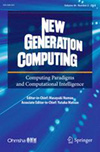
NEW GENERATION COMPUTING
新一代計(jì)算
- 期刊周期:Quarterly
- 研究方向:工程技術(shù)
- 影響因子:0.833
- 通訊地址:SPRINGER, 233 SPRING ST, NEW YORK , USA, NY, 10013
- 官網(wǎng):http://www.springer.com/computer/ai/journal/354
- 投稿地址:http://www.ohmsha.co.jp/ngc/instruction.htm
- 審稿速度:>12周,或約稿
中文簡(jiǎn)介
本雜志旨在支持各種研究領(lǐng)域交叉施肥產(chǎn)生的新的計(jì)算和認(rèn)知范式的發(fā)展。這些領(lǐng)域包括但不限于編程(邏輯、約束、功能、面向?qū)ο螅⒎植际?并行計(jì)算、基于知識(shí)的系統(tǒng)、面向代理的系統(tǒng)以及人類(lèi)具體知識(shí)的認(rèn)知方面。它還鼓勵(lì)有關(guān)所有類(lèi)型的學(xué)習(xí)、知識(shí)發(fā)現(xiàn)、進(jìn)化機(jī)制、人類(lèi)認(rèn)知和學(xué)習(xí)的理論和/或?qū)嵺`論文,以及能夠引導(dǎo)我們構(gòu)建更復(fù)雜和智能系統(tǒng)的關(guān)鍵技術(shù)的新興系統(tǒng)。編委會(huì)希望新一代的計(jì)算技術(shù)能夠通過(guò)確保出版過(guò)程的順利進(jìn)行,在具有廣泛興趣的活躍研究人員中起到催化劑的作用。新一代計(jì)算涉及的領(lǐng)域包括:學(xué)習(xí):學(xué)習(xí)的基礎(chǔ)和模型,計(jì)算學(xué)習(xí)理論,語(yǔ)法推理,歸納邏輯編程,統(tǒng)計(jì)學(xué)習(xí)方法,貝葉斯網(wǎng)絡(luò),強(qiáng)化學(xué)習(xí)數(shù)據(jù)挖掘:頻繁模式挖掘、流數(shù)據(jù)挖掘、圖形和網(wǎng)絡(luò)挖掘、關(guān)系數(shù)據(jù)挖掘、文本和Web挖掘、數(shù)據(jù)挖掘的統(tǒng)計(jì)方法、數(shù)據(jù)挖掘的機(jī)器學(xué)習(xí)方法、數(shù)據(jù)挖掘的可視化方法。認(rèn)知計(jì)算:建模人類(lèi)知識(shí)、建模人類(lèi)問(wèn)題解決與學(xué)習(xí)、語(yǔ)義計(jì)算、建模與分析決策、認(rèn)知架構(gòu)、人工通用智能、人級(jí)人工智能。編程和語(yǔ)義:計(jì)算的基礎(chǔ)和模型,計(jì)算邏輯,編程系統(tǒng),聲明式編程,并發(fā)和并行,量子計(jì)算。生物和納米系統(tǒng)的控制理論:分子系統(tǒng)的形式模型,基于令牌系統(tǒng)的計(jì)算,自然界中信號(hào)的非布爾表示,基于自然界中發(fā)現(xiàn)的機(jī)制的細(xì)胞自動(dòng)機(jī)。生物/納米/分子計(jì)算與工程:分子機(jī)器人與人工細(xì)胞、DNA納米工程、分子計(jì)算/編程、自組織系統(tǒng)。技能科學(xué)與哲學(xué):生活中的技能與知識(shí)、交流與社會(huì)技能、身技能與知識(shí)的學(xué)習(xí)、“感性”與價(jià)值創(chuàng)造、體育科學(xué)、身體運(yùn)動(dòng)的測(cè)量與分析、身體系統(tǒng)論、技能科學(xué)的認(rèn)知方法、本體感覺(jué)的主觀言語(yǔ)化、共同進(jìn)化身體和語(yǔ)言的n,符號(hào)接地,符號(hào)生成計(jì)算社會(huì)科學(xué):社會(huì)媒體、網(wǎng)絡(luò)服務(wù)、網(wǎng)絡(luò)挖掘、社會(huì)研究、語(yǔ)義網(wǎng)絡(luò)、眾包、社會(huì)系統(tǒng)、社會(huì)模擬、虛擬實(shí)驗(yàn)室
英文簡(jiǎn)介
The journal is specially intended to support the development of new computational and cognitive paradigms stemming from the cross-fertilization of various research fields. These fields include, but are not limited to, programming (logic, constraint, functional, object-oriented), distributed/parallel computing, knowledge-based systems, agent-oriented systems, and cognitive aspects of human embodied knowledge. It also encourages theoretical and/or practical papers concerning all types of learning, knowledge discovery, evolutionary mechanisms, human cognition and learning, and emergent systems that can lead to key technologies enabling us to build more complex and intelligent systems. The editorial board hopes that New Generation Computing will work as a catalyst among active researchers with broad interests by ensuring a smooth publication process.Areas covered in New Generation Computing include:Learning: Foundations and Models of Learning, Computational Learning Theory, Grammatical Inference, Inductive Logic Programming, Statistical Learning Methods, Bayesian Networks, Reinforcement LearningData Mining: Frequent pattern mining, Stream Data Mining, Graph and Network mining, Relational Data Mining, Text and Web Mining, Statistical methods for Data Mining, Machine learning methods for Data Mining, Visualization methods for Data MiningCognitive Computing: Modeling Human Knowledge, Modeling Human Problem Solving and Learning, Semantic Computing, Modeling and Analyzing Decision Making, Cognitive Architecture, Artificial General Intelligence, Human Level AI.Programming and Semantics: Foundations and Models of Computation, Computational Logic, Programming Systems, Declarative Programming, Concurrency and Parallelism, Quantum Computing.Control Theory of Bio- and Nano-systems: Formal Models of Molecular Systems, Computation by Token-based Systems, Non-Boolean Representations of Signals in Nature, Cellular Automata Based on Mechanisms Found in Nature.Bio/Nano/Molecular Computing and Engineering: Molecular Robotics & Artificial Cells, DNA Nanoengineering, Molecular Computing/Programming, Self-organizing Systems.Skill Science and Philosophy: Skills and Knowledge in Life, Communication and Social Skills, Learning of Embodied Skills and Knowledge, “Kansei" and Value Creation, Sports Science, Measurement and Analysis of Body Movements, Systems Theory of Body, Cognitive Approach of Skill Science, Subjective Verbalization of Proprioceptive Sense, Co-evolution of Body and Language, Symbol Grounding, Symbol GenerationComputational Social Science: Social Media, Web Services, Web Mining, Social Studies, Semantic Web, Crowdsourcing, Social Systems, Social Simulation, Virtual Lab
近年期刊影響因子趨勢(shì)圖
相關(guān)工程技術(shù)SCI期刊推薦
- SemimonthlyADVANCED MATERIALS
- Journal of Materials Chemistry A
- MonthlyADVANCED FUNCTIONAL MATERIALS
- SemimonthlyAPPLIED CATALYSIS B-ENVIRONMENTAL
- SemimonthlyJOURNAL OF HAZARDOUS MATERIALS
- SemimonthlyJOURNAL OF ALLOYS AND COMPOUNDS
- MonthlyBiotechnology for Biofuels
- Materials Science & Engineering C-Materials for Biological Applications
- MonthlySmall
- MonthlyJOURNAL OF THE ELECTROCHEMICAL SOCIETY
SCI期刊欄目
SCI期刊 工程技術(shù) 物理 生物 化學(xué) 醫(yī)學(xué) 農(nóng)林科學(xué) 數(shù)學(xué) 地學(xué)天文 地學(xué) 環(huán)境科學(xué)與生態(tài)學(xué) 綜合性期刊 管理科學(xué) 社會(huì)科學(xué)
期刊論文百科問(wèn)答
- sci投稿中關(guān)于online常見(jiàn)的問(wèn)題匯總
- 攝影藝術(shù)領(lǐng)域AHCI期刊推薦《Photography And Culture》
- Nature旗下多學(xué)科子刊Nature Communications
- 中小學(xué)教師值得了解,這些教育學(xué)期刊發(fā)論文容易被人大復(fù)印轉(zhuǎn)載
- 2025年寫(xiě)管理學(xué)論文可以用的19個(gè)選題
- 測(cè)繪領(lǐng)域科技核心期刊選擇 輕松拿捏
- 及時(shí)開(kāi)論文檢索證明很重要
- 中國(guó)水產(chǎn)科學(xué)期刊是核心期刊嗎
- 國(guó)際出書(shū)需要了解的問(wèn)題解答
- 合著出書(shū)能否評(píng)職稱?
